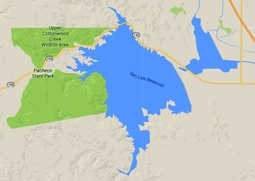-This is a caption display style to be used for describing various media items including photos and videos.
SACRAMENTO – The Department of Water Resources (DWR) changed the algal bloom advisory for San Luis Reservoir from Warning to Caution today based on two consecutive weeks of tests that revealed lower toxicity levels at Basalt Boat Launch. Caution signs are being posted at the reservoir in Merced County. A Warning advisory had been in effect since September 15. O’Neill Forebay remains free of algal bloom advisories.
While swimming is allowed, all recreational users are still urged to avoid direct contact with bluegreen algae (cyanobacteria) in the reservoir. The algae bloom can appear as blue-green, white, or brown foam, scum, or mats that can float on the water’s surface and accumulate along the shoreline. Bloom conditions can change rapidly, and wind and waves may move or concentrate the bloom into different regions of the reservoir.
Blue-green algae can pose health risks, particularly to children and pets. Visitors to San Luis Reservoir are urged to choose safe water activities while recreating there. They should avoid ingesting the water, and pets should be kept away from the water.
Recreational exposure to toxic blue-green algae can cause eye irritation, allergic skin rash, mouth ulcers, vomiting, diarrhea, and cold and flu-like symptoms. Pets can be especially susceptible because they tend to drink while in the water and lick their fur afterwards.
The Statewide Guidance on Cyanobacteria and Harmful Algal Blooms recommends the following for waters with blue-green algae:
- Take care that pets and livestock do not drink the water, swim through algae, scums, or mats or lick their fur after going in the water. Rinse pets in clean water to remove algae.
- Avoid wading, swimming, or jet or water skiing in water containing algae blooms, scums, or mats.
- Do not drink, cook, or wash dishes with untreated surface water from the reservoir under any circumstances. Common water purification techniques such as camping filters, tablets, and boiling do not remove toxins.
- People should not eat mussels or other bivalves collected from the reservoir. Limit or avoid eating fish taken from these waters; if fish are consumed, remove the guts and liver, and rinse filets in clean drinking water.
- Get medical treatment immediately if you think that you, your pet, or livestock have been poisoned by blue-green algae toxins. Alert a medical professional, and contact the local county public health department.
For more information, visit:
State Water Resources Control Board – California CyanoHAB Network:
http://www.mywaterquality.ca.gov/monitoring_council/cyanohab_network/index.html
CA Office of Environmental Health Hazard Assessment: Information on Microcystin
http://oehha.ca.gov/ecotoxicology/general-info/information-microcystins
US Environmental Protection Agency: CyanoHAB website
https://www.epa.gov/nutrient-policy-data/cyanohabs
#####
Every Californian should take steps to conserve water. Find out how at SaveOurWater.com.
